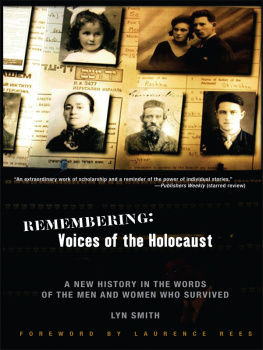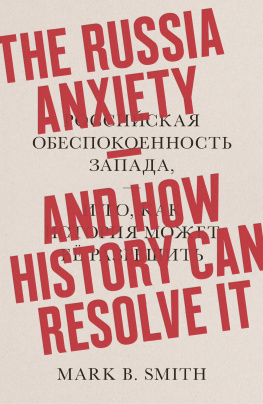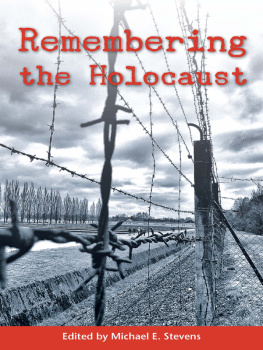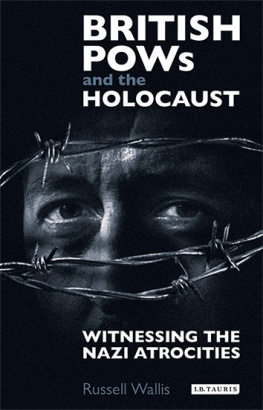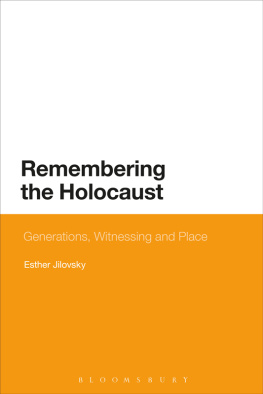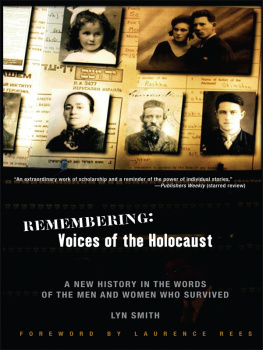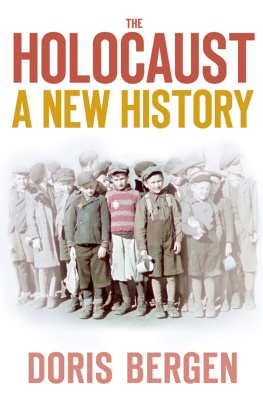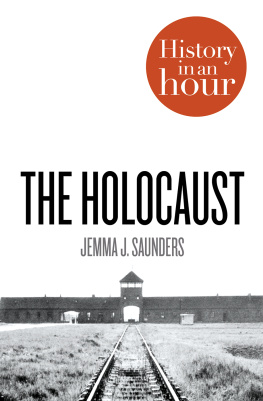Praise for Remembering:
Voices of the Holocaust
Very few men are still alive who fought in the trenches in the
First World War. The words of the soldiers, however, are as fresh as
if they were written yesterday in Max Arthurs
[Remembering: Voices of the Holocaust]... extraordinary
Deborah Moggach, The Mail on Sunday
These stories are so harrowing, and their witness so
precise and devastating
Andrew Motion
Oral history older people being encouraged to tape their
memories has opened up vast new vistas of social, political and
military research. Just look at the historian Max Arthurs fantastic
new book, [Remembering: Voices of the Holocaust].
It draws on the Imperial War Museums sound archive to chronicle
the First World War as it has never been chronicled before: through
the vivid recollections of the poor blokes in the trenches
Richard Morrison,The Times(London)
An extraordinary and immensely moving book
Stephen Fry
It is a collection of transcribed interviews with survivors of the war.
Ordinary men and women, the blurb calls them. Extraordinary is
more like it
The Times Books
Tailor-made for classroom use as well as maximum impact on the
general reader
TES,Book of the Week
An impressive anthology of eye-witness experiences which does
not short-change us on the horror and filth, the pity and terror of
that dreadful conflict
The Herald,Glasgow
This book is not just a particular, compelling and important record,
it is in its own way as fine a memorial as the memorials in
towns and villages to all those who never returned to their own
country, and a reminder to future generations of the real
horrors of trench warfare
NauticalMagazine
The testimonies are vivid and many are compelling. They are
gruesome and dark in places, with no holds barred when it comes to
describing wounds and horrors at the front... everyone who
loves oral history will enjoy the often harrowing accounts
contained in this book
History Today
A compelling account of a world not to be forgotten
Despatches
REMEMBERING:
VOICES OF THE HOLOCAUST
REMEMBERING:
VOICES OF THE HOLOCAUST
A New History in the Words of the
Men and Women Who Survived
LYN SMITH
CARROLL & GRAF PUBLISHERS
NEW YORK
REMEMBERING: VOICES OF THE HOLOCAUST
A New History in the Words of the Men and Women Who Survived
Carroll & Graf Publishers
An Imprint of Avalon Publishing Group Inc.
245 West 17th Street
11th Floor
New York, NY 10011

Copyright 2005 Lyn Smith
First Carroll & Graf edition 2006
First Carroll & Graf reade paperback edition 2007
First published in Great Britain by Ebury Press 2005
Photographs The Imperial War Museum UK and United States Holocaust Memorial Museum Washington D.C.
Epigraph (from The Book of Laughter and Forgetting, page 3) reproduced by permission of Milan Kundera, Faber and Faber, London, 1982.
Permission, given by Mrs. Evelyn Friedlander, to quote from Albert Friedlander, Riders Towards the Dawn, Constable London 1993.
All rights reserved. No part of this book may be reproduced in whole or in part without written permission from the publisher, except by reviewers who may quote brief excerpts in connection with a review in a newspaper, magazine, or electronic publication; nor may any part of this book be reproduced, stored in a retrieval system, or transmitted in any form or by any means electronic, mechanical, photocopying, recording, or other, without written permission from the publisher.
Library of Congress Cataloging-in-Publication Data is available.
ISBN-13: 978-0-78671-922-8
ISBN-10: 0-78671-922-2
eBook ISBN: 9780786734061
9 8 7 6 5 4 3 2 1
Printed in the United States of America
Distributed by Publishers Group West
The struggle of men against power is the
struggle of memory against forgetting.
Milan Kundera
Authors Preface
I first became aware of the Holocaust sixty years ago as World War II ended. In particular it was the newspaper and newsreel images of the emaciated bodies being bulldozed into mass graves in Bergen-Belsen concentration camp that shocked me into an entirely different perspective of the war which I had spent in relatively sheltered circumstances as a child evacuee in the Sussex countryside. Yet, although thousands of inmates Jews and non-Jews perished there of starvation and disease in the most terrible conditions, Bergen-Belsen did not reveal the full horror of the Holocaust because it was not a Nazi death camp as such. There were no planned massed killings, gassings or crematoria. The Final Solution the mass extermination of Jews and gypsies took place farther east in the six designated death camps situated in occupied Poland, Auschwitz being the most infamous.
Working as a freelance interviewer for the Imperial War Museums Sound Archive in 1978 gave me the opportunity and privilege of recording testimonies of men and women who had been directly affected by the Nazi Holocaust. This was a pioneering project on the topic; it covered refugees who had fled Nazi Germany in the 1930s and who had been interned as enemy aliens during the invasion scare of 1940, as well as their pre-war lives and experiences of the rise of Hitler.
Over the next two decades, along with other interviewers, I continued recording the Holocaust story. By then Holocaust was interpreted by the Sound Archive to include not only the millions murdered or imprisoned by the Nazis during the period 193345, but also those whose lives were affected by Hitlers policies, or who were witnesses to the persecution and atrocities. Therefore, refugees, families of the murdered and of survivors, aid workers and troops who liberated the camps were included. It was due to this broad definition that I came full circle when meeting and recording the late Bill Essex the soldier who had the gruesome task of bulldozing the piles of bodies into the mass graves of Bergen-Belsen in April 1945.
When planning for the permanent Holocaust Exhibition started in the mid 1990s, the recording programme was expanded. Survivor testimony was to have a key role in the exhibition which was opened by HM The Queen in the Millennium year. Today there are 785 Holocaust-related recordings in the Sound Archive. It is from this extensive, rich and varied archive that over a hundred voices have been selected for this book. In order to give as full a picture as possible, these have been supplemented with a small, complementary range from the United States Holocaust Memorial Museum in Washington, DC.
Throughout my interviewing and transcribing work, I have been impressed with the unique nature of each survivors experience. Every man, woman and child experienced and coped with their ordeal in their own way Roman Halter, for instance, who summoned his murdered family to his bedside each evening to give account of his survival for yet another day; or George Hartman, whose desire to experience love and sex gave him the will to live. Different reactions are given to wearing the Star of David: the pride expressed by Janice Ingram and Anna Bergman compared with the shame and humiliation felt by Jan Hartman and Harry Lowit. Each person experienced their own particular portion of Holocaust history and not one had a complete overview of the monstrous system in its entirety.

